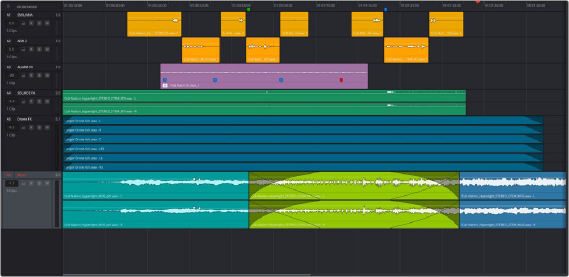< Previous | Contents | Next >
![]()
The heart of the Fairlight page, the Audio Timeline presents the audio channels and tracks of the currently selected timeline differently than the Edit page does, in a one-channel-per-track format that’s optimized for audio mixing and sweetening. The Audio page Timeline cannot be closed.

The Audio Timeline

Audio layering in a mono audio track
The Fairlight page of DaVinci Resolve supports multiple audio tracks, and each audio track may contain multiple lanes. The clips edited into the Timeline appear within each track, with the recorded channels within each clip occupying as many lanes as that clip has available. At the left of each track is a header area that contains a number of controls.
The Fairlight page differs in another unique respect from the Edit page Timeline, in that it supports audio layering. Audio layering is a special audio editing mode that lets you superimpose multiple audio clips in the same track, and whatever audio clip is on top dictates which audio will play. In a way, when audio layering is enabled, superimposed audio clips are treated the same as superimposed video clips that all have opacity set to 100%, with clips on top obscuring (or muting) clips underneath.

Turning on Track Layers opens up space to edit more audio into each track

TIP: Track Layering can be used on the Edit page as well.
TIP: Track Layering can be used on the Edit page as well.
TIP: Track Layering can be used on the Edit page as well.
![]()